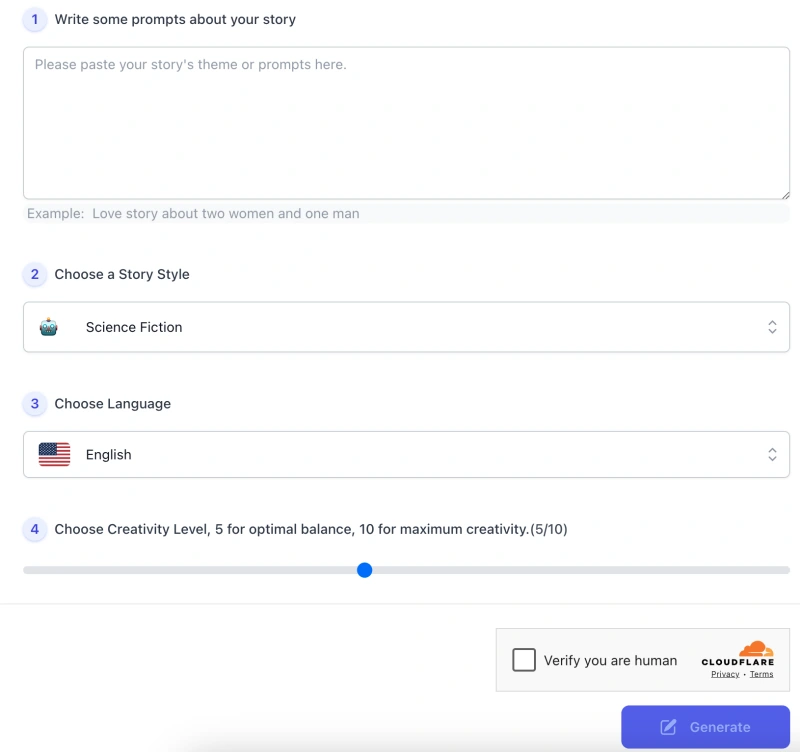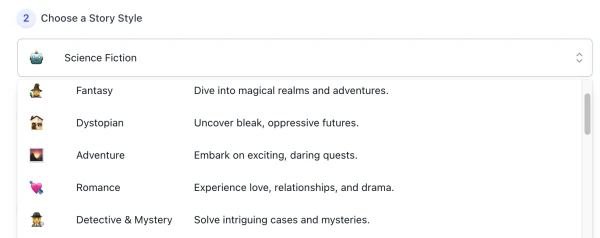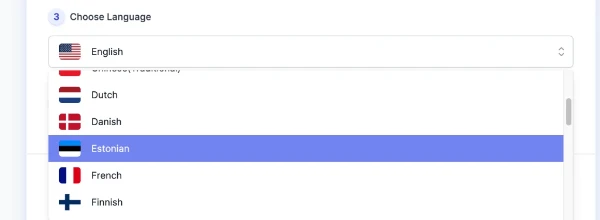This page is your go-to resource for crafting stories with the AI Story Generator. It covers how the tool works, the kinds of narratives you can build, and how to shape them to reflect your own voice and intent. You’ll find practical tips, usage guidance, potential limitations, ways to troubleshoot hiccups in the writing process, and answers to common questions—all designed to support you as the storyteller, not replace you.
What Can AIFreeBox AI Story Generator Do?
Powered by AIFreeBox’s language engine, the AI Story Generator takes your prompt, and starts building the foundation of a story. It identifies key elements like characters, setting, and narrative direction, then shapes the plot with pacing and tone that match your selected genre. Each of the 25 built-in styles—from slow-burning mysteries to whimsical folklore—adds its own voice and rhythm, helping your story feel grounded in the world you imagine. And with support for 33 languages, you can write stories in your native tongue—or explore storytelling across cultures.
This tool isn’t built for quick, generic output. It’s made to help you move past creative blocks, escape tired formulas, and find new possibilities in your own storytelling. Whether you’re outlining a chapter or just experimenting with an idea, it’s here to support your voice—not replace it.
AIFreeBox Story Generator vs. Generic Text Generator
This table highlights the key differences in core value and output — showing why the AI Story Generator is built for real storytelling, not random text.
| 🔹 Dimension |
✨ AI Story Generator |
✏️ Generic Text Generator |
| 🎯 Core Purpose |
Designed to craft full, emotionally engaging stories with structure and depth. |
Produces plain text or short paragraphs without context or focus. |
| 📚 Narrative Structure |
Builds story arcs with clear beginnings, conflicts, and resolutions. |
Outputs unconnected sentences lacking flow or coherence. |
| 🎨 Style & Genre |
Includes 25+ preset styles like Fantasy, Romance, Mystery — defining tone and pace. |
No awareness of genre or tone; all outputs feel the same. |
| ⚙️ Creative Control |
Creativity slider balances imagination and logic for better storytelling. |
Fixed randomness; users can’t adjust style or depth. |
| 🤝 Human Collaboration |
Co-creation focus — AI drafts, you refine for voice and emotion. |
One-way output with little room for user input. |
| 💡 Output Quality |
Coherent, ready-to-edit story drafts for blogs, books, or classes. |
Fragmented or repetitive text needing heavy rewriting. |
| 🚀 Real User Impact |
Helps overcome creative blocks and deliver professional story flow. |
Generates generic content with limited creative value. |
| 🏆 Core Value |
Turns ideas into structured, human-feeling stories through guided AI support. |
Outputs unstructured text lacking emotion or narrative logic. |
In essence, the AI Story Generator helps you write stories that feel human — structured, expressive, and original — unlike generic tools that simply generate text.
Recommend Use Cases & Strengths
| Recommended For |
Best Used To |
Strengths |
| 📖 Aspiring writers |
Develop ideas, break through creative blocks |
Adapts to tone, genre, and writing voice |
| ✍️ Fandom writers |
Create narratives for existing characters or explore Alternate Universe (AU) plots |
Dedicated tool for character dynamics and established settings |
| 🎮 Game designers |
Create quests, backstories, and world lore |
Supports nonlinear and world-driven narratives |
| 🧑🏫 Educators & students |
Generate prompts, build writing exercises |
Clear structure, flexible complexity, multi-language support |
| 🧵 Content creators |
Write short fiction for blogs, socials, emails |
Quick idea-to-draft output in 30+ languages |
| 🌍 Multilingual users & learners |
Write stories in your native or target language |
Supports 33 languages for global accessibility |
How to Create a Story with AIFreeBox AI: Step-by-Step Guide

Creating a story with this tool is simple—and intentionally designed to keep your creativity in focus. Follow these five quick steps to turn an idea into a narrative:
1. Describe your story idea
- Write a short prompt that captures the essence of your story. It can be a character, a situation, a sentence, or even a mood.
- Example: “A quiet girl who discovers a hidden world under her school.”
2. Choose a story style

- Select from 25+ storytelling genres. From sci-fi to folklore, each style shapes the tone, pacing, and narrative form of your output.
- The genre you choose defines the world your story will grow in.
3. Select your language

The tool supports story generation in 33 languages, making it easy to write in your native tongue—or explore storytelling across cultures.
4. Set your creativity level
Use the slider to control how imaginative the AI should be.
- Level 5 gives a balanced, structured story.
- Level 10 goes full creative—great for surprising twists or abstract ideas.
5. Click “Generate”
- In seconds, you’ll receive a full story draft based on your input. You can review, revise, or rerun the process to explore new directions.
If you’re unsure how to start, just describe a character or a feeling. This tool is here to support your voice—so you can spend more time creating, not formatting.
6. Report Bug for Real Human Support

If you encounter any issue, click Report Bug. Your message goes to a real support team who actively monitors and resolves problems to keep the tool stable and user-focused.
Tips for Better AI Stories
- Start with something specific
A clear character, setting, or conflict gives the AI a stronger base to build from than a vague idea.
- Match the genre to your idea
If your story is emotional, try Romance or Coming-of-age. If it’s plot-driven, consider Thriller, Adventure, or Mystery.
- Use the creativity slider with intent
Lower levels (3–5): more structured, grounded storytelling.
Higher levels (7–10): more imaginative, risk-taking writing.
- Rerun with variations
Slight changes in your prompt can lead to entirely new versions of the story—use this to explore different angles.
- Edit the draft like your own work
Treat the output as a first draft. Add your voice, change lines, reshape pacing—it’s your story, not the AI’s.
User Case Studies: How People Actually Use It
To help you understand how the AI Story Generator performs in real creative scenarios,
this section shows true-to-life examples of human–AI collaboration.
Each case demonstrates how users transform a simple idea into a polished story —
proving that AI supports creativity, but never replaces it.
🎨 Case 1: From One Sentence to a Full Short Story
User Input: “A young girl discovers a hidden world beneath her school.”
Selected Style: Fantasy 🧙
AI Output (First Draft): The AI generated a 300-word draft about a secret magical library guarded by talking owls. The tone was whimsical and imaginative, but slightly generic.
User Refinement: The user kept the setting but rewrote the protagonist’s dialogue, added emotional motivation, and expanded the ending into a cliffhanger.
Final Result: A 600-word fantasy short story blending AI-generated structure with human emotion and style — now ready for sharing or adaptation.
🧠 Case 2: Overcoming Writer’s Block for a Dystopian Plot
User Input: “A city where emotions are illegal.”
Selected Style: Dystopian 🏚️
AI Output: A dark, futuristic scene describing government-issued emotion trackers and the sterile silence of daily life.
User Refinement: The user deepened the emotional contrast — introducing a rebellious scientist who secretly keeps memories of joy — turning the concept into a layered short story.
Outcome: A complete story outline with compelling moral conflict, created in half the usual time and used later for a classroom writing project.
💘 Case 3: Adding Heart to a Romance Scene
User Input: “Two old friends meet again at a small seaside café after years apart.”
Selected Style: Romance 💘
AI Output: A gentle reunion scene filled with nostalgia and visual detail — pleasant but lacking depth.
User Refinement: The user added backstory, emotional subtext, and subtle pauses in dialogue, transforming it into a heartfelt short piece about memory, timing, and forgiveness.
Outcome: A moving, publishable micro-story that balances AI’s structure with human warmth and authenticity.
These examples highlight what makes the AI Story Generator unique: it doesn’t write for you — it writes with you.
Each story begins with your vision, shaped through AI guidance and refined by your creative judgment.
The result is a smoother, faster, and more inspiring storytelling process that always keeps the human voice at its core.
Available Story Styles & Genres
The AI Story Generator offers a wide range of storytelling styles designed to match your creative vision.
Each preset shapes the tone, pacing, and atmosphere of your story — helping you build immersive, emotionally engaging narratives.
- 🤖 Science Fiction – Explore futuristic technologies, space travel, and new worlds shaped by innovation or chaos.
- 🧙 Fantasy – Enter magical realms filled with quests, mythical beings, and timeless adventures.
- 🏚️ Dystopian – Reveal grim societies and oppressive futures where survival demands courage.
- 🌄 Adventure – Follow brave heroes on thrilling journeys through unknown lands and challenges.
- 💘 Romance – Capture the beauty and complexity of love, relationships, and emotional discovery.
- 🔍 Mystery – Unravel clues, expose secrets, and solve compelling puzzles that keep readers guessing.
- 👻 Horror – Confront fear and suspense in chilling tales that test the limits of human courage.
- 😱 Thriller – Build tension and intrigue through fast-paced plots and unexpected twists.
- 🏳️🌈 LGBTQ+ – Celebrate diverse identities and authentic expressions of love and belonging.
- 🏰 Historical Fiction – Relive distant eras through vivid, character-driven reimaginings of history.
- 🧑 Young Adult (YA) – Explore growth, self-discovery, and transformation during adolescence.
- 🧸 Children’s Fiction – Tell imaginative, heartwarming stories full of wonder and curiosity.
- 🌱 Coming-of-Age – Portray journeys from youth to adulthood through personal growth and change.
- 📜 Classic – Embrace timeless storytelling with elegant prose and deep character focus.
- ⚔️ Epic – Chronicle legendary heroes, grand battles, and sweeping sagas of destiny.
- 🐢 Fabulation – Blend morality and imagination in fables with surprising twists.
- 🧚 Folklore (Folktale) – Retell traditional stories rooted in culture, myth, and symbolism.
- 😂 Comedy – Bring laughter and wit through clever dialogue and playful storytelling.
- 👁️🗨️ Paranormal – Encounter ghosts, psychic forces, and the mysteries beyond reality.
- 💾 Cyberpunk – Step into neon-lit dystopias where technology meets rebellion.
- 🃏 Satire – Critique society and human behavior through irony and humor.
- 🤠 Western – Ride through tales of justice, grit, and freedom on the frontier.
- ☢️ Post-Apocalyptic – Survive in worlds rebuilt from the ashes of catastrophe.
- ✍️ Literary Fiction – Explore introspective themes and nuanced human experiences.
- ⚙️ Steampunk – Discover alternate histories powered by steam and imagination.
Each style preset fine-tunes the AI’s narrative voice, influencing dialogue balance, descriptive depth, and story rhythm. Whether you’re writing a chilling dystopia or a heartfelt romance, your selected style defines the creative direction — ensuring every story you generate feels authentic, distinctive, and truly yours.
⚠️ Limitations and Common Issues
| Issue / Limitation |
What’s Happening |
How to Fix It |
| 🌀 Story feels repetitive or flat |
The prompt may be too vague or lack conflict |
Add more detail—include characters, stakes, or emotional tone |
| 📚 Too much plot, not enough emotion |
The AI focuses on events instead of depth |
Use emotion-driven genres like Romance or Coming-of-age, and describe feelings in your prompt |
| 🌐 Language output feels unnatural |
Some languages may generate more literal or robotic phrasing |
Refine the prompt, simplify complex expressions, or try a different creativity level |
| ⚙️ Genre mismatch in the result |
The story tone may not reflect the selected genre |
Align your prompt with the genre’s typical style and setting |
| 📝 Output is too short |
Minimal input may limit narrative complexity |
Provide more context—like motivation, setting, or backstory—and consider lowering creativity slightly |
This tool works best when treated like a creative partner, not just a generator.
FAQs
Is the AI Story Generator fully automatic?
No. It’s designed for collaboration — the AI provides structure, tone, and inspiration, while you make creative choices, refine dialogue, and add emotional depth. You remain the author of the final story.
Can it generate a complete story from just one sentence?
Yes, it can create a strong first draft based on your prompt and selected style. However, the result should be treated as a creative starting point, not a finished product. Your input and revisions are essential to make it truly unique.
How accurate are the styles and tones?
Each preset adjusts tone and pacing to match its genre (e.g., Romance, Mystery, or Sci-Fi). Still, tone can vary slightly depending on your input. You can regenerate or fine-tune prompts for better alignment.
Is the output ready for publication?
No. The generated text is meant for inspiration and drafting only. Always review, edit, and supplement with your own details before publishing or sharing publicly.
How can I improve the quality of results?
Be specific: include key details about characters, setting, or conflict. Choosing the right style and adjusting creativity level also helps balance structure and imagination.
Is my data safe?
Yes. Your text is processed securely and never stored or used to train AI models. All content remains private and is deleted after your session ends.
Can it help with school or professional writing?
Yes — it’s ideal for brainstorming, learning structure, or overcoming writer’s block. But you must always rewrite in your own words and verify factual or contextual details before submission.
What’s the best way to use this tool?
Think of it as a writing partner: let AI provide the draft and framework, then you refine tone, add emotion, and ensure the story matches your authentic voice. Collaboration is key to the best results.
✍️ Creator’s Note
I designed the AI Story Generator for people who want to write—but sometimes don’t know where to start. A blank page can be daunting. A half-formed idea can stall. This tool was built to give you something to react to, to reshape, to make your own.
It doesn’t pretend to know your voice. But it listens well. And with the right prompt, it can help you move forward—faster, deeper, and more confidently.
I hope it becomes a quiet part of your process. Not the answer. Just the push.
— Matt Liu
📖 Ready to unleash your imagination? Install the Free AI Story Generator for Chrome
Turn your ideas into captivating stories — let AI guide your imagination, not replace it.



